Why Yazd City Listed As UNESCO World Heritage?
Yazd: Living Harmoniously with the Desert

Yazd city is listed as a UNESCO World Heritage Site because of its exceptional testimony to the cultural traditions of the region and its unique architecture. The city, which is located in central Iran, has a rich history that dates back to the 5th century BC and has been an important center of trade, culture, and spirituality for centuries.
One of the main reasons for Yazd’s inclusion on the UNESCO World Heritage list is its well-preserved historic center, which includes a wide range of traditional buildings and structures that reflect the city’s history and culture. The city’s traditional architecture, which is characterized by the use of adobe and other local materials, is a unique and well-preserved example of the vernacular architecture of the region.

Contents
Brief Overview of Yazd
Yazd, often referred to as the “City of Wind Catchers,” is one of the oldest continuously inhabited cities in the world. Located in the heart of the Iranian plateau, this ancient city stands as a testament to human adaptability and architectural ingenuity in the face of a harsh desert environment.
Geographical Setting
Yazd is situated in central Iran, surrounded by the vast Dasht-e Kavir desert. Its location, distant from major seas and fresh-water sources, means it experiences an arid climate, with scorching summers and mild winters.

Historical Importance
With a history spanning over 5,000 years, Yazd has been a center of Zoroastrian culture. The city was a significant stopover on the ancient Silk Road, linking it with trade centers of the time, fostering a rich cultural exchange. Its remote desert location also played a role in preserving its architectural and cultural treasures from wars and invasions.

Architectural Mastery
One of the most distinct aspects of Yazd is its adaptive architecture. The skyline is punctuated by “badgirs” or wind catchers, ancient air-conditioning systems designed to trap cooler breezes and direct them into homes. Equally impressive are the qanats, an intricate network of underground channels, which have provided the city with a sustainable water source for centuries. The mud-brick homes, with their high walls and narrow lanes, are another iconic feature, designed to provide shade and keep the city cool.
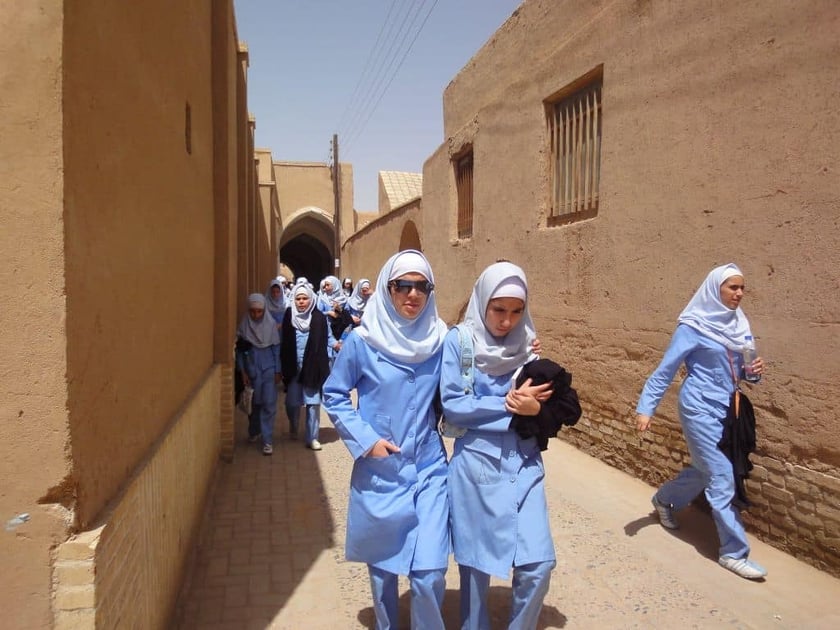
Cultural Tapestry
Beyond its architectural wonders, Yazd has a rich cultural fabric. It’s one of the few places where the ancient religion of Zoroastrianism is still practiced, and the city is dotted with fire temples and towers of silence. The city’s bazaars and streets vibrate with life, offering a blend of ancient traditions and modern sensibilities.
UNESCO Recognition
In 2017, Yazd was inscribed on the UNESCO World Heritage list. The recognition wasn’t just for its impressive architectural feats or its ancient history, but for the harmonious way in which its residents have adapted to their environment, making the most of limited resources and turning challenges into opportunities.
Historical Background
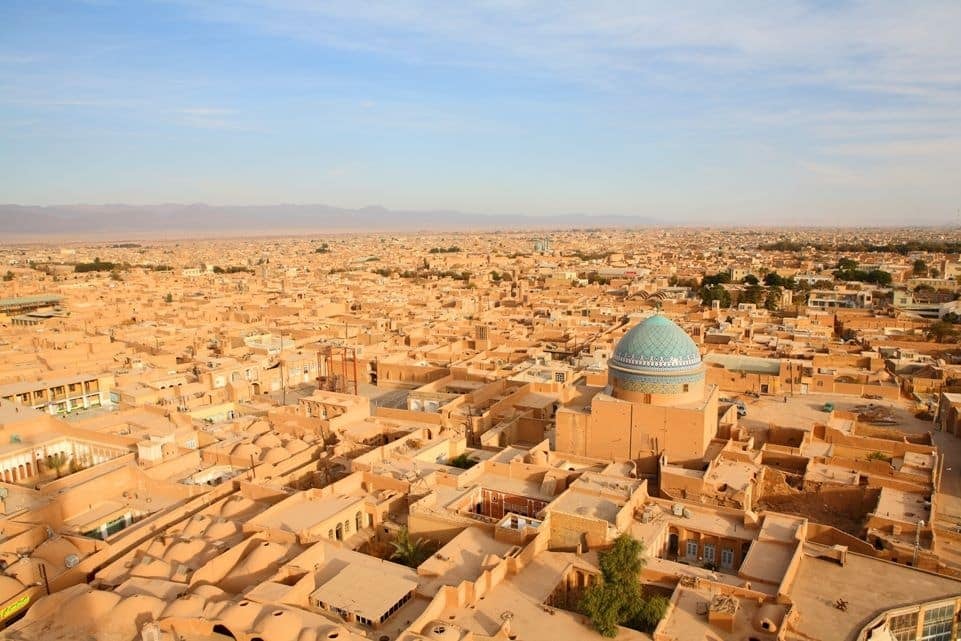
Ancient Beginnings
Yazd’s origins can be traced back to the time of the Medes, an ancient Iranian people. Archaeological finds suggest that the region around Yazd has been settled for over 5,000 years, making it one of the oldest continuously inhabited cities on Earth.

The Silk Road: A Conduit of Culture and Commerce
Located strategically between the east and the west, Yazd flourished as a hub on the famed Silk Road. Caravans loaded with spices, silks, and precious goods passed through its gates, bringing with them not just merchandise, but ideas, art, and knowledge. This exposure to a myriad of cultures enriched the city’s own heritage and turned it into a melting pot of civilizations.
Zoroastrianism: The Flame That Burns Bright

Perhaps the most defining aspect of Yazd’s historical identity is its deep connection with Zoroastrianism, one of the world’s oldest monotheistic religions. Long before the advent of Islam, Zoroastrianism was the dominant faith of Persia.
Even after the Arab conquests of the 7th century CE, which led to the widespread adoption of Islam, Yazd remained a stronghold of Zoroastrianism. Today, it’s home to one of the largest Zoroastrian communities in Iran, with many fire temples and sacred sites scattered across the city.
Invaders, Conquerors, and Dynasties
Despite its remote desert location, Yazd has seen its fair share of invaders and rulers. From the Achaemenids and Sassanids to the Seljuks and Safavids, various dynasties have left their mark on the city. However, due to its geographical isolation, Yazd was often spared the brunt of invasions, allowing it to retain much of its original character and heritage.
Modern Times: Preserving the Past
The 20th and 21st centuries have brought significant changes to Yazd, with modernization and development shaping its urban landscape. Yet, the city’s deep reverence for its history has ensured that modernity doesn’t overshadow tradition. Efforts have been made to preserve ancient structures, and the city’s World Heritage status further reinforces its commitment to safeguarding its rich past.
Architectural Marvels
Yazd’s architecture is an embodiment of human adaptation, innovation, and a deep appreciation for aesthetics, all set against the backdrop of a challenging desert environment. This has led to the creation of some of the most iconic and unique architectural wonders that resonate with both function and beauty.

Wind Catchers (Badgirs): The Ancient Air Conditioners
One of the defining features of Yazd’s skyline is its wind catchers, locally known as badgirs. These tall, chimney-like structures, often adorning houses and other buildings, are ancient air conditioning systems. Designed ingeniously, they capture the cooler desert breezes and direct them downwards into the living spaces, while simultaneously expelling the hotter air from inside.

Qanats: Lifeblood of the Desert City
Another marvel of ancient engineering is the qanat system. These are underground channels dug deep into the earth, bringing fresh water from the mountain aquifers to the city. Given the arid conditions of the desert, these qanats were vital for survival, providing water for drinking, agriculture, and other needs. The construction and maintenance of qanats are testaments to the advanced understanding of hydrology and civil engineering in ancient Persia.

Mud-Brick Houses: Eco-Friendly Before It Was Cool
The majority of Yazd’s historical buildings are constructed using mud bricks. This not only provided an easily available material but also had the advantage of being an excellent insulator against the desert’s extreme temperatures. The thick walls of these homes, often whitewashed to reflect the sun’s rays, provide cool interiors during the scorching summers and retain warmth during chilly winters.

Jameh Mosque of Yazd: A Spiritual and Architectural Landmark
Dominating the old city is the Jameh Mosque of Yazd with its soaring minarets, the highest in Iran. The mosque, adorned with intricate blue tilework and elegant calligraphy, is a magnificent representation of Persian mosque architecture. The intricate geometric patterns and the play of light and shadow within its premises create an ambiance of spiritual tranquility.

Dowlat Abad Garden: A Persian Paradise
An epitome of Persian garden design, Dowlat Abad Garden showcases the integration of nature and architecture. With its central pavilion boasting one of the tallest wind catchers, the garden is a delightful blend of water channels, fountains, plants, and shade-giving trees. It’s a testament to the Persian aesthetic principle of creating a paradise on earth.
Culture

The Zurkhaneh: Traditional Houses of Strength
Translating to “Houses of Strength”, Zurkhaneh are traditional gymnasiums where the ancient sport of Varzesh-e Bastani is practiced. Not only are they places of physical training, but also spiritual discipline. The octagonal or circular architecture of these gymnasiums, combined with their sunken pits and domed ceilings, make them unique and worth a visit.
The cultural tapestry of Yazd is rich, vibrant, and intricately woven with threads of ancient traditions, religious practices, and centuries-old customs that have withstood the test of time. The city’s cultural significance is not just a reflection of its past but is also a living entity, dynamically shaping and being shaped by its inhabitants.

Zoroastrianism: A Living Legacy
Yazd is a stronghold of Zoroastrianism, one of the world’s oldest monotheistic religions. The flame that has been burning in the Zoroastrian Fire Temple of Yazd, the Atash Behram, is said to have been alight for over 1,500 years. The presence of Towers of Silence on the city’s outskirts, where the deceased were once placed to be exposed to the elements, stands as a testament to the ancient funerary practices of this religion. While the number of adherents has dwindled, the essence of Zoroastrianism is still palpable in Yazd’s festivals, rituals, and daily life.
Festivals and Celebrations
The city comes alive with numerous festivals and celebrations, each with its own charm. From the Persian New Year, Nowruz, marked by spring cleaning, family gatherings, and festive meals, to the ancient festival of Jashn-e Sadeh, which celebrates the discovery of fire, Yazd’s calendar is replete with events that reflect its cultural richness.

The Art of Handicrafts
Yazd is renowned for its handicrafts, especially its silk weaving and the production of Termeh, a traditional handwoven cloth. This art form, passed down through generations, represents the meticulous craftsmanship and aesthetic sensibilities of Yazd’s artisans. The city’s bazaars are a hub of activity where one can witness the age-old tradition of handicraft production, from pottery and ceramics to intricate metalwork.
Gastronomic Delights
No cultural exploration is complete without delving into local cuisine. Yazd offers a palette of flavors that are both unique to the region and a testament to its cultural amalgamation. From the refreshing sharbat (traditional drinks) to delicacies like gheimeh yazdi (a local stew) and sweet treats like baghlava and pashmak, Yazd’s culinary scene is a feast for the senses.

Oral Traditions and Storytelling
For centuries, Yazd has been a center for oral traditions and storytelling. Traditional coffeehouses and gathering spots often echo with tales of heroes, folklore, and ancient Persian legends. These narratives, passed down orally, are a vital cultural repository, preserving the wisdom, values, and imagination of generations.

Music and Dance
Music and dance form an integral part of Yazd’s cultural landscape. Whether it’s the rhythmic beats of dohol (a large drum) during celebrations or the soulful melodies echoing in a caravanserai, the city’s musical traditions are a reflection of its emotional depth and artistic prowess.

The Persian Garden and Its Role in Yazd
The Persian Garden, often referred to as a piece of heaven on earth, is not just an aesthetic concept but a profound reflection of Persian culture, philosophy, and the human relationship with nature. These gardens, with their intricate designs and elements, play a vital role in cities like Yazd, especially considering the challenging desert environment.
Origins of the Persian Garden
The concept of the Persian Garden dates back to ancient times, deeply rooted in the Zoroastrian ethos of balancing elements: earth, water, wind, and fire. These gardens symbolized paradise, known as pairidaeza in ancient Persian, from which the word “paradise” is derived.
Fundamental Elements
Every Persian Garden, regardless of size or location, incorporates four key elements:
- Water: Central to the garden’s design is water, representing life and vitality. Water channels, often lined with tiles and fed by qanats, crisscross the gardens, nourishing plants and providing a cooling atmosphere.
- Shade: Trees are carefully chosen and planted to offer shade, protecting visitors from the sun’s harsh rays and creating a serene atmosphere.
- Geometry: The layout of a Persian Garden is typically symmetrical, reflecting the universe’s order. Paths and water channels often divide the garden into four sections, symbolizing the Zoroastrian elements.
- Enclosure: High walls usually enclose Persian Gardens, ensuring privacy and creating a microclimate that retains moisture and keeps the interior cooler than the external environment.
Dowlat Abad Garden: Yazd’s Gem
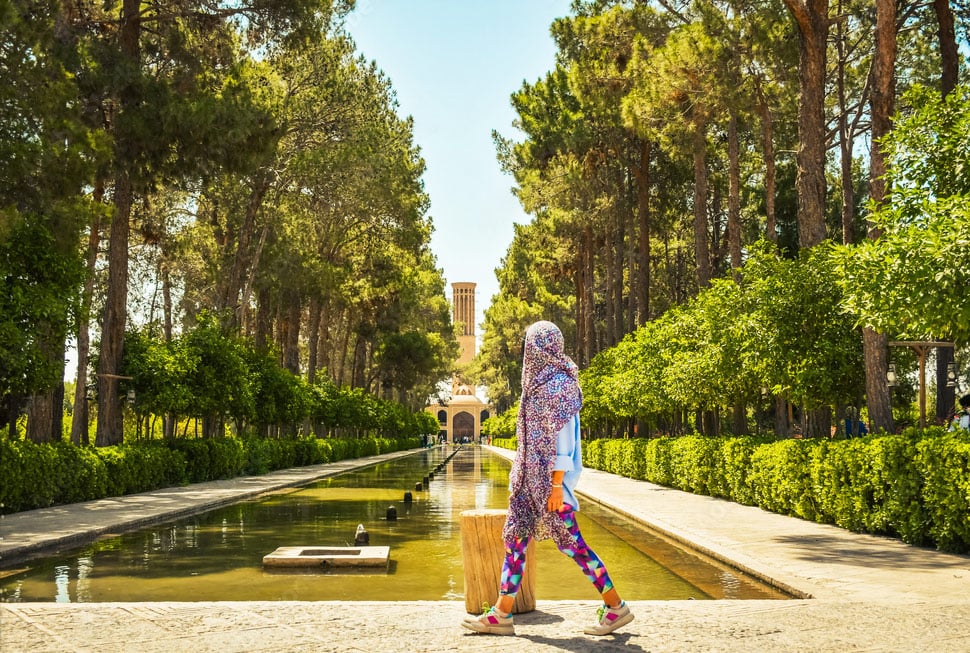
Dowlat Abad Garden in Yazd is a perfect embodiment of the Persian Garden’s principles. Established during the Afsharid dynasty, it boasts one of the tallest wind catchers, which, in combination with the garden’s water features, provides natural cooling. The garden demonstrates how architectural innovations can harmoniously blend with nature, making it not just a place of beauty but also a technological marvel.
Role in City Planning
In Yazd, as in many Persian cities, gardens played a pivotal role in urban planning. Beyond providing recreational spaces, these gardens were:
- Ecological Havens: Offering biodiversity and helping combat desertification.
- Climate Moderators: Cooling the immediate surroundings and acting as urban lungs.
- Socio-cultural Centers: Serving as venues for gatherings, poetry recitations, and musical evenings.
Sustainable Practices

The underlying philosophy of Persian Gardens is sustainability. In an arid environment like Yazd, these gardens exemplify resourcefulness—maximizing the use of scarce water through efficient irrigation, selecting drought-resistant plants, and employing architectural features to cool spaces naturally.
Modern Relevance
Today, as the world grapples with climate change and sustainability challenges, the principles of the Persian Garden offer lessons in creating green spaces that are not only beautiful but environmentally conscious. They stand as a testament to the timeless wisdom of harmoniously coexisting with nature.
In conclusion, the Persian Garden is not merely an architectural or aesthetic feature; it’s a profound expression of Persian ethos, ingenuity, and the age-old quest for balance. In Yazd, amidst the desert’s starkness, these gardens bloom as symbols of resilience, beauty, and the eternal human desire to create sanctuaries of peace.

The Urban Oasis: Living Harmoniously with the Desert
Yazd, often termed the ‘Bride of the Desert’, stands as a beacon of how civilizations can flourish in the heart of a harsh, unforgiving desert landscape. Over millennia, its inhabitants have developed ingenious methods to harness, adapt to, and coexist with their environment. This remarkable balance between man and nature has transformed Yazd into an urban oasis, showcasing the perfect symphony of tradition, innovation, and sustainability.
Adapting to Nature’s Call
The arid conditions and scarce water supply in Yazd could have been deterrents to human habitation. However, the city’s forebears, rather than seeing these as challenges, saw opportunities:
Qanats

An ancient underground water management system, qanats tapped into the mountain aquifers to provide a consistent water supply. These tunnels ensured that water remained cool, even in soaring temperatures, and reduced evaporation losses.
Wind Catchers (Badgirs)

These architectural marvels were built atop houses and other structures, acting as natural ventilation systems. They captured cool breezes and circulated them within buildings, making interiors comfortable during hot summers.
Mud-Brick Construction

Traditional Yazdi houses were constructed using thick mud-bricks, which offered excellent insulation. The properties of these bricks helped keep homes cool in summers and warm in winters.
Social and Cultural Harmony with the Desert
The desert environment has not only shaped Yazd’s architecture and agriculture but also deeply influenced its social and cultural fabric:
- Community Cooperation: Constructing and maintaining qanats required community efforts. This fostered a sense of community cooperation and collective ownership.
- Festivals and Rituals: Many local festivities, like the water-sharing rituals during periods of scarcity, emerged from the desert lifestyle.
- Art and Craft: Local handicrafts, such as pottery and weaving, often carried motifs and designs inspired by desert landscapes and life.
Lessons for Modern Urban Planning
As cities worldwide face challenges of climate change, resource management, and urbanization, Yazd’s model offers valuable lessons:
- Harmonizing with Nature: Instead of resisting or altering the natural environment, work in tandem with it.
- Sustainability: Opt for sustainable architectural and agricultural practices that are rooted in local knowledge.
- Community Engagement: Engaging local communities in resource management can foster a sense of shared responsibility and better conservation.
Recommended Places to Visit and Activities in Yazd
Yazd, with its enchanting blend of ancient history, architectural wonders, and unique desert charm, offers a plethora of experiences for travelers. Here are some must-visit places and recommended activities:
Places to Visit
Amir Chakhmaq Complex

An iconic landmark in Yazd, the Amir Chakhmaq Complex features a stunning three-story façade filled with symmetrical sunken alcoves. The site is particularly captivating when lit up in the evening, offering a mesmerizing view that adds to the allure of Yazd.
Address:
Amir Chakhmaq Sq, Yazd, Iran
View on Google Maps
Zoroastrian Fire Temple

The Zoroastrian Fire Temple is another must-visit site in Yazd. The temple is home to a sacred flame that’s said to have been burning since AD 470. This place offers visitors valuable insights into Zoroastrianism and its historical significance in Yazd and Iran as a whole.
Address:
Kashani St, Yazd, Iran
View on Google Maps
Towers of Silence (Dakhma)

These intriguing, circular, raised structures, known as Towers of Silence or Dakhma, are located on the outskirts of Yazd. Historically used for sky burials in Zoroastrian tradition, they offer a unique perspective on ancient burial customs.
Address:
Safaieh Area, Yazd, Iran
View on Google Maps
Dowlat Abad Garden

Dowlat Abad Garden is a classic example of Persian gardens. This UNESCO World Heritage site boasts the tallest windcatcher in the world, and the garden itself offers a serene escape, complete with fountains, trees, and historical buildings.
Address:
Shahid Rajaei St, Yazd, Iran
View on Google Maps
Water Museum

The Water Museum in Yazd offers a comprehensive understanding of the ancient qanat system, highlighting how water has been sourced and distributed in this desert city for centuries.
Address:
Kohan Sq, Yazd, Iran
View on Google Maps
Yazd Jameh Mosque

The grand Jameh Mosque of Yazd is renowned for its stunning entrance, towering minarets, and intricate blue tilework. A masterpiece of Islamic architecture, this mosque is a testament to the artistic and spiritual heritage of Yazd.
Address:
Masjed Jame St, Yazd, Iran
View on Google Maps
For a deeper dive into the travel attractions of Yazd, you may want to check out this comprehensive guide on our SURFIRAN website.
Activities to Engage In
Roam the Old Town

Wandering through the labyrinthine lanes of Yazd’s Old Town is like taking a step back in time. The area is replete with mud-brick houses, archways, and windcatchers that are emblematic of traditional Persian architecture. This part of the city is a photographer’s dream, offering countless opportunities to capture the essence of Yazd.
Address:
Old Town, Yazd, Iran
View on Google Maps
Desert Excursions

A trip to the nearby deserts, such as Dasht-e Kavir or Dasht-e Lut, promises a unique and thrilling experience. Whether you’re riding camels, stargazing, or simply soaking in the vast and hauntingly beautiful desert landscapes, these excursions offer a memorable adventure.
Address:
Dasht-e Kavir and Dasht-e Lut, Near Yazd
View on Google Maps
Attend a Zurkhaneh Session
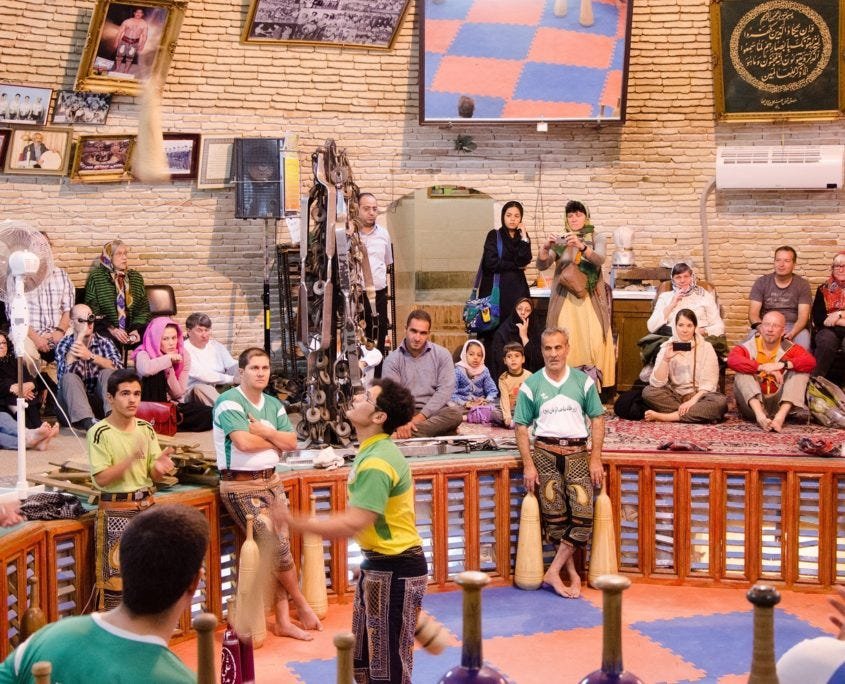
Zurkhaneh is a traditional Iranian gymnasium where participants engage in a unique blend of physical exercise, spiritual rituals, and rhythmic drumming. Witnessing a Zurkhaneh session is an excellent way to immerse yourself in Iranian culture and tradition.
Address:
Various locations in Yazd
View on Google Maps
Shop in the Bazaars

The historic bazaars in Yazd offer a cornucopia of traditional Iranian handicrafts. From Termeh (handwoven fabric) to local sweets like baghlava and pashmak, as well as pottery and other souvenirs, the bazaars are a shopper’s paradise.
Address:
Central Bazaar, Yazd, Iran
View on Google Maps
Taste Local Delicacies
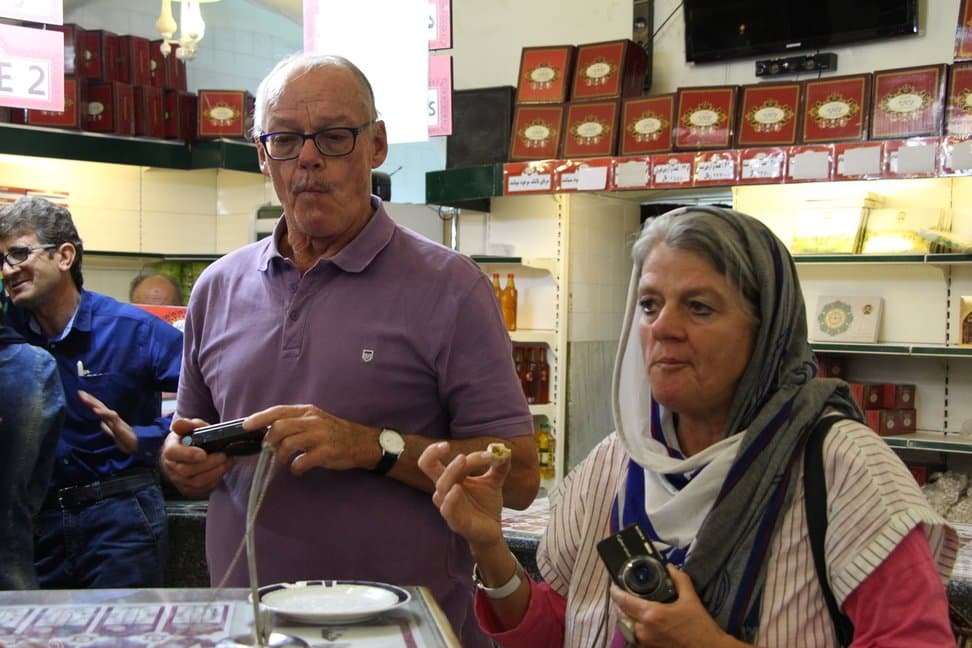
Savor the unique flavors of Yazd by trying local dishes like Ash-e Shuli, Kebab Tabeh, and Gheimeh Yazdi. And don’t forget to indulge in Yazd’s famous confectionery specialties, available at various eateries throughout the city.
Address:
Haj Khalifeh Rahbar in Yazd city
View on Google Maps
Stay in a Historic House

For a genuinely authentic experience, consider staying in one of Yazd’s converted historic houses or caravanserais. These accommodations offer a unique blend of traditional Persian hospitality and modern amenities.
Address:
Various locations in Yazd. Dad 4-star hotel recommended
View on Google Maps
Attend Local Festivals
If your visit coincides with local festivals or religious observances, it’s a golden opportunity to immerse yourself in the rich culture and traditions of Yazd. These events offer fascinating insights into local customs and are often accompanied by traditional music and dance.
Address:
Various locations in Yazd
View on Google Maps
With its captivating blend of history, culture, and natural beauty, Yazd promises a memorable experience for every traveler. Whether you’re an architecture enthusiast, a history buff, or simply looking to experience the magic of a desert city, Yazd has something to offer.






